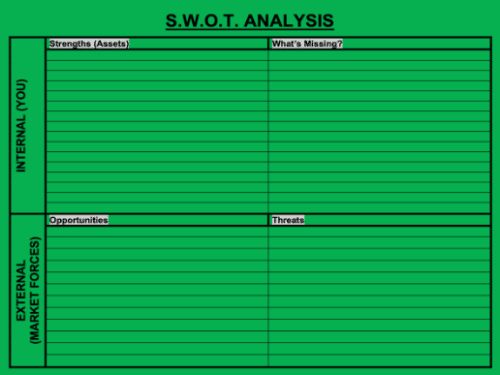Table of Contents
I’ve been a Career Trainer for the past 20 years, working with people all over the world. For the past 5-1/2 years, I’ve designed and taught career courses for the Adult Education Department at Los Angeles Pierce College. One of the most effective tools I use is the SWOT Analysis (the letters stand for Strengths, Weaknesses, Opportunities, and Threats), first developed in the mid-1960s as a strategic tool to help organizations with project planning and dealing with competitors. I’ve adapted it for the individuals I coach and teach.
My courses teach people how to self-market in The Gig Economy. It’s projected that more than half the labor force in the U.S. will be gig workers before the end of the decade. Like it or not, all these people will be their own brand and business.
Outlining The SWOT Analysis
Let’s suppose you, the reader, are constructing your own SWOT Analysis. Here is how it would work:

Strengths
The top two quadrants in the chart relate to you as an individual. The top left quadrant is Strengths. In the context of marketing your personal brand, this asks: what specific skills do you have that people will pay for? What have you done that is monetizable? This can include degrees, licenses, certificates, languages in which you’re fluent, software programs and apps in which you’re proficient, and specific accomplishments. It does not include soft skills (hard worker, team player, fast learner, etc.).
What’s Missing
The top right quadrant, traditionally called “Weaknesses,” I’ve re-labeled as “What’s Missing.” Say you want to be an R.N. Your Strengths quadrant may include- a college degree in Pre-Med, experience volunteering in a hospital, and an LVN. The “What’s Missing” quadrant would include the R.N. degree.
Your task is always to move “What’s Missing” into “Strengths.” After all, no matter how much passion for or experience in healthcare you have, no one is going to hire you as an R.N. without your having an R.N. degree.
Opportunity & Threats- Market Conditions
The bottom two quadrants relate to market conditions.
To continue with the example of your goal of being an R.N.: before you spend time or money to earn that degree, you need to research the field. What are the Opportunities (bottom left quadrant)? How much can you expect to earn as an R.N.? If your degree costs you $50,000 and you can’t expect to earn more than $20,000 a year, that’s probably not a good investment.
Resources For Gig Economy Planning
You’ll also want to look at:
- what nursing specialties are growing and will offer the most compensation?
- in what geographic locations will you find the least competition, the most opportunities, and the best pay?
- what are the long-term growth prospects in the field?
The place to start is The Bureau of Labor Statistics, part of the United States Department of Labor. Its Occupational Outlook Handbook will prove useful, as well.
Threats
Finally, there is the bottom right quadrant, Threats. These can include: a tight labor market, robots replacing human workers, consolidation in that industry, offshoring, etc., etc. You need to be open to the idea that as badly as you may want to do something, this may not be the right time to start. And further, be open to never being able to pursue that dream.
You need to know what factors might impede you from attaining your career goals. And again, you need to do this research before you begin working towards that goal.
Gig Economy Example
Let’s say you’ve discovered your passion for photography and decided to become a full-time photographer. Your research will show you that the field is contracting. People use very sophisticated cameras on their smartphones, can’t really discern the difference in quality between an image shot on their phone and one shot on a 35mm camera, and don’t see the point of hiring a professional photographer.
Maybe being a professional photographer is not the right move for you at this time. Maybe you need to look at it as your hobby and not your vocation.
Making Passions Monetized Using the SWOT Analysis
To use myself as an example: I began teaching about 20 years ago and quickly found that I enjoyed it immensely and had a real talent for it. With an M.A., I began teaching at the college level.
After about ten years, I decided to earn my doctorate with an eye on becoming a tenured professor at a local university. I did the first part (Ed.D.), but the second part proved problematic.
It’s become virtually impossible to find a tenure-track position in a large and very competitive market like Los Angeles. Tenure is slowly dying off. So teaching has become one income stream among many. Though it is lucrative, it’s not my only source of income. It lies somewhere between my sole vocation and a hobby. The SWOT Analysis allowed me to see this and plan my future before I began working towards my Doctorate.
SWOT Analysis Creates Success
The SWOT Analysis is a wonderful tool. Because you’ve written everything on a computer screen or a sheet of paper, there is no drama, and it provides a clear picture of what you need to do to get where you want to go when you’re planning the next stage in your career. Like a map or a blueprint, it helps you avoid taking wrong turns and wasting your time and money.

